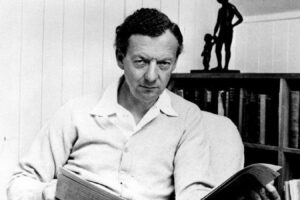

He has sung with Early Music groups and avant-garde ones, and he has a taste for projects that cross artistic boundaries, which suits an innate showmanship with something of the Pentecostal preacher teaching a stern lesson combined with the preening actor drawing his audience into the story he feels like telling.
Therefore Davóne’s recital was no ordinary recital, which delighted many listeners (the event was sold out) but annoyed a few overheard on the way out, who felt the program was too brief and too focused, for the specimen song recital they had hoped for.
But perhaps the old-fashioned style of song recital is on its way out; perhaps something new is being constructed (by singers like Joyce DiDonato and Nicholas Phan and Barbara Hannigan) with its roots in the Liederabend.
Entitled “Recital No. 1: MASS,” Tines’ program, given without the interruption of applause or of pauses to applaud in (he hurtled right on, from section to section, creating a unit of his multifarious sources), was a conglomerate of musical texts using the Catholic Mass, that combination of invocations, praises, prayers for mercy and statement of creed, as a template for musical construction and meditation.
The Catholic Mass has been set to music more times, by more different composers, than any text ever written, but Tines does hardly bothers with it—other than to perform the Greek Kyrie, the Latin Agnus Dei and Sanctus, and these are suggestions for meditation. It is the message that he wishes to dwell on, the story he wants to tell us through song of a soul’s journey—his own and ours. He has turned to several composers to set it and to help him tell it.
There were two Bach arias, with the messages “How sorry I feel for those perverted hearts” (from BWV 170) and “Make yourself pure, my heart” (from the St Matthew Passion), which do not allow us to relax into soothing melodies but seek a certain meaning of the texts and din them into our ears, musically yes, but with the tension, the unsung question: “Do you get it? Do you understand why I’m saying this?”
There were several spirituals, sung in a Black church style, with emphatic melismas, pointing certain words, lingering on prayers, beseeching and guiding the way. (Margaret Bonds, whose setting of Countee Cullen’s “To a Brown Girl, Dead,” was given an eloquent reading, said she would consider no honor higher than to share a recital program with Bach.)
The spirituals recomposed by Tyshawn Sorey (“Were You There?” and “Swing Low, Sweet Chariot”) and Moses Hogan (“Give Me Jesus”), sung with emotional resort to sermonizing vocal technique, console and exalt but also caution us, Tines’s congregation, to consider the ends of life, the purposes of existence. Each listener may take this in her or his own way, but the use of music, declamation, performance is to make us pause and consider.
Julius Eastman’s Prelude to The Holy Presence of Joan d’Arc is a setting of Joan’s vision of saints commanding her to speak. As Tines sang it, this was abrupt, forceful, imperative. “Speak boldly when they question you.” Responsibility and courage are demanded of Joan, and of each of us, speaking truth to power or the inquisition or anyone else. No weakness, no shyness will be tolerated: Spread that message! Tines was stern as any preacher in any pulpit; his saints are not reserved or genteel.
All the techniques he has studied, in church and in conservatory classroom and in a Renaissance music group, were brought into play, marshaled to his sermonizing, his guided meditations.
The accompanist (for those pieces not sung a cappella) was Adam Nielsen, a subtle, supportive pianist.


























Comments